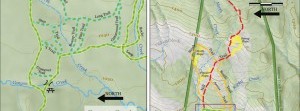Monster Snowfalls
You can tell when the big snowfalls are coming.
After a cold snap, clouds build in the southern sky and winds switch from blowing downriver to strong blasts out of the southeast. Soon, large, lazy, saucer-sized snowflakes start to twirl out of the sky. Like moose heading for shelter under old-growth trees, old-timers make one last hurried trip to stock up on groceries and park their vehicles closer to the road.
Heavy snowfalls are a fact of life if you live in the north coast’s inland valleys. Every winter, residents of Kitimat, Terrace and Stewart, and even the caretakers at the Kitsault ghost town, prepare themselves. With colder winter temperatures than coastal communities like Prince Rupert and Bella Bella, these towns sit in the zone where major Pacific cyclonic storms blowing onshore pass over higher land, dropping heavy precipitation. If cold air is trapped in the valley bottoms, this precipitation can become massive amounts of snow.
The resulting depths can be staggering. They bring traffic to a stop, crush sheds, rip gutters from roofs, crush greenhouses and isolate residents until the streets and sidewalks are cleared. Local residents joke about having one of the highest per-capita ownerships of snow shovels, snow blowers and four-wheel drives. Local contractors count on snow removal as a major contributor to annual income.
If you live in a less-snowy part of the North, it is hard to imaginet. Think of the hood of your car. On average, it is about 80 cm above the ground. During one record-breaking snowfall on Feb. 11, 1999, over 24 hours an unbelievable 113 cm of snow fell in Terrace. Although my workplace at the time let everyone go early, I could scarcely make it back down my street, past small cars already stuck in the banks. These cars soon disappeared under the growing snow cover.
By next morning, the snowpack was chest level. With snowshoes, we were able to move around the yard to feed our chickens and rabbits, but had to dig to get in the sheds’ doorways. By noon, the snow was melting and heavy rain was falling. Despite building codes requiring strong, weight-bearing trusses in these snow-belt communities, we decided that shovelling the consolidating snowpack off our roofs was the safest choice. It was like moving chunks of sticky, white cement. Limited access
These snowfalls are spectacular reminders of the stormy north coast’s severe winter climate. On a regular basis, large snow dumps change the reality of living in this region. As recently as last February, heavy snowfall reminded industrial developers that the Northwest is not a benign climate when 151 cm fell over two days in Terrace. In Kitimat, it was a staggering 160 cm.
The mobilization of heavy equipment after a snowfall like that is impressive, but the result is often major road closures accompanied by flooding, avalanches and power outages from broken trees. If an industrial catastrophe occurred during an event like the 2015 storm, access to an affected site would be problematic, if not impossible.
Big snowfalls that quickly melt are one thing, but what happens if monster snowfalls stay and accumulate? Stewart, at the head of the Portland Canal, averages 570 cm of snowfall per year—higher than the roofline of many houses. Although some melts during the winter, in many years it builds up deeper and deeper, requiring trailers to have protective roofs and frequently closing the road into Stewart because of avalanches in the Bear Pass.
One early spring a few years back, we had to travel to Stewart. Deep banks of blue snow lined the streets, dramatically illustrating why many of the old mining houses have metal roofs and are elevated several feet above the ground. The force of the thick accumulation of wet snow that year tore porches from the fronts of older houses. A bus-sized recreation vehicle sat at the side of a residential street, torqued and twisted by the weight of metres of snow that had accumulated on it.
With climate change, will heavy snowfalls become something of the past? Climatic models suggest that, despite winters becoming warmer elsewhere, the future outer-north-coast weather may be wetter and cooler. Inland valleys will still sit in a transition zone between these wet coastal influences and colder continental weather. As in the past, there will be years where snow never accumulates in the valleys, and there will be other years where it will start snowing in November and not melt until March. People of the Snow
The 1970s are legendary for snow accumulation in Kitimat and Terrace folklore. Not only did it snow a lot, the snow accumulated on the ground until life became very challenging. According to one resident, “The dog was walking around on the roof of the house. We kept shooing him off, but all he did was go back up the snow bank and onto the roof again. The fence was buried. We had to dig down into the doorway of the garage, and we just parked the car out at the road. Every day, there was more snow. I was throwing the snow up on to the banks until there wasn’t any more room for snow. It got so bad, people moved away.”
Climatic records bear out these descriptions of the ’70s. For example, from November 1971 to the end of March 1972, Terrace received 715 cm of snow. That is over 23 feet: the height of a power pole. In Kitimat, there was an astounding 1,016 cm of snowfall during the same period. The snow was so deep, it touched the hydro lines and some residents used their second-storey windows to go in and out of their houses. Driving down the roads was like driving through a white tunnel. These marathons of snow continued through the 1970s. One can still come across logging settings harvested at this time, with tree stumps sitting two or three metres above ground level, where timber had been cut during the deep snow.
The inland coastal valleys have a long history of monster snowfalls. According to Gordon Robinson, historian for traditional Haisla knowledge, Kitimaat got its name People of the Snow from the shoulder-deep snow of the area. Historic records show the amazing snowfalls and deep snow covers have long been recorded as a consistent factor of living in this transitional snowbelt zone.
Last February, as we watched the snow in our driveway become an impassable barrier, the lights flickered, then went off. “Better wrap the deep freezers in the sleeping bags,” someone said. “This might be a long one.”



